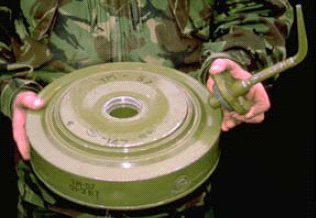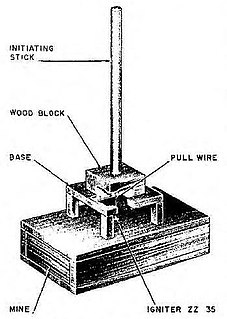
The Tellermine 43 was a German circular steel cased anti-tank blast mine used during the Second World War. It was a simplified version of the Tellermine 42, which enabled simpler production techniques. Between March 1943 and the end of World War II, over 3.6 million Tellermine 43s were produced by Germany. Copies of the mine were produced by several countries including Denmark (M/47), France and Yugoslavia (TMM-1).

The TM-57 mine is a large, circular Soviet metal-cased blast anti-tank mine. It can either be triggered by a pressure or a tilt-rod fuze. A development of the TM-46 mine, it is found in Africa, the Middle East, and South East Asia.

The TM-46 mine is a large, circular, metal-cased Soviet anti-tank mine. It uses either a pressure fuze or tilt-rod, which is screwed into the top. Anti-tank mines with this type of fuze were capable of inflicting much more damage to armored vehicles. The TMN-46 is a variant of the mine fitted with a secondary fuze well on the bottom which is slightly off-set from the centre of the mine. This secondary fuze well can be fitted with a pull-fuze which functions as an anti-handling device. The mine was used by the North Vietnamese forces during the Vietnam War, and is found in many countries in Africa, the Middle East and South East Asia.

The AT2 mine is a scatterable anti-tank mine developed by Dynamit Nobel. It can be scattered from artillery rockets or from mine laying systems, and was used by the British, German and Norwegian armed forces until the signing of the Ottawa Treaty.

The M15 mine is a large circular United States anti-tank blast mine, first used during World War Two. Essentially, it is a larger version of the M6A2 anti-tank mine, which it replaced. Although the M15 has been superseded by the M19 mine, the U.S. retains large stocks of M15s because they are still regarded as reliable and effective weapons. When used against main battle tanks the M15 is primarily a "track-breaker" which creates mobility kills, but has a comparatively small likelihood of causing crew fatalities. However, when used against lighter vehicles such as APCs or unarmored vehicles such as trucks the damage inflicted is much more severe.

The VS-1.6 is an Italian circular plastic-cased scatterable anti-tank blast mine. It has very few metal components and is resistant to overpressure and shock. The mine can also be deployed conventionally and from helicopters. It was produced by Valsella Meccanotecnica, but production has ceased.

The VS-50 is a circular plastic cased anti-personnel blast mine, formerly manufactured by the now-defunct Valsella Meccanotecnica SpA, an Italian high-tech defence industry specialized in area denial systems which was also the manufacturer of the Valmara 69 and one of the first industries in the world to implement plastic construction for landmines. The design is similar to the TS-50 and VS-MK2 mine. It is blast resistant and can be used in a minimum metal configuration. Though unlikely to kill, the explosive charge contained within a VS-50 is quite sufficient to destroy the victim's foot: the blast is capable of penetrating 5 mm of mild steel leaving an 80 mm-diameter hole.
The SB-81 is an Italian plastic cased minimum metal anti-tank blast mine dating from the early 1980s. The mine uses an air pressure based fuze, which gives it protection against overpressure and blast. It can therefore be regarded as a blast resistant mine. The mine can be scattered by hand or by mine laying systems.
The Panzer-Stabmine 43 was a German anti-tank mine, together with the Hohl-Sprung mine 4672 it was the first mine to combine a shaped charge warhead with a tilt-rod fuze. The mine was developed during the Second World War. The mine consisted of a wine glass shaped metal main body mounted on a wooden post, with a tilt rod holding arm projecting to one side. It used a 125 mm diameter warhead with 1.6 kg of explosive, and a combination pressure/tilt fuze.
The M21 is a circular United States anti-tank landmine that uses a Misznay Schardin effect warhead. The mine uses an M607 pressure fuse, which can be adapted as a tilt rod fuze. The mine is triggered either by pressure, or by the tilt rod being forced beyond 20 degrees from the vertical by a force of more than 1.7 kg, either of these actions results in pressure being transferred via a bearing cap to a Belleville spring, which inverts, driving the firing pin into the M46 detonator. The M46 charge first ignites a black powder charge, which blows off the mine's cover, and clears any earth or debris that may have been on top of the mine. A fraction of a second later the main warhead detonates, driving and compressing a steel plate upwards, with enough force to penetrate 76 mm of armour at a distance of 530 mm. Approximately 200,000 M21 mines were produced in the U.S. and a licensed copies, the K441 and K442, were produced in South Korea.
The No 6 mine is an Israeli metal-cased anti-tank blast mine. It is a direct copy of the Russian TM-46 mine, the only notable difference being the filling cap, which is domed on the TM-46 and flat on the No 6. It can be fitted with the No 61 pressure fuze or a No 62A tilt rod fuze. The mine is found in the Falkland Islands, Israel, Lebanon and Oman.
The VS-AT4 and VS-AT4-EL are Italian minimum metal blast resistant anti-tank blast mines. The VS-AT4 uses a blast-resistant mechanical pressure fuze, while the VS-AT4-EL uses a programmable electronic pressure fuze with an integral anti-lifting function.
ADWAT is a French anti-tank blast mine used with the Matenin mine laying system. The mine has the same casing as the MI AC PR series of mines. The mine has a mechanical and electronic fuze. The mine incorporates a 30-minute arming delay, after which either the electronic or mechanical fuze can trigger the mine. The electronic fuze can be programmed using an external programmer with a three-pin connection to self-neutralize, self-destruct and act as an anti-handling device, with an active period of between one and 365 days.
The PT Mi-Ba is a circular Bakelite cased Czechoslovakian minimum metal anti-tank blast mine. The mine entered service with the Czech and Slovakian armies in the 1950s and is now obsolete and no longer in service. The mine is conventional in layout with a central pressure plate, and doughnut-shaped main charge around a booster charge and RO-7-II fuze. The mine's fuze is the only component that contains any metal, and this is limited to a spring, the striker pin, and the detonator capsule.
The PDM amphibious mines are series of Soviet anti-vehicle mines that could be used on or in beaches, rivers, lakes and shallow coastal waters up to five meters deep.
The Model 52 mine is a Swedish circular plywood cased anti-tank blast mine. It is in service with the Swedish army. The mine can be fitted with a number of different fuzes and pressure plates including a three pronged plate and a pentagonal pressure spider and a tilt-rod fuze.
The Adrushy is an Indian glass-reinforced, plastic-cased anti-tank landmine.
The PT Mi-P is a large Czechoslovakian anti-tank mine. The mine is a large hemisphere, with a carrying handle and an RO-9 attachment for a tilt rod on one side. It uses a large shaped charge warhead that uses a five millimeter thick steel liner, and can penetrate up to 150 millimeters of armour. The mine was in service with the armies of the Czech Republic and Slovakia, but is now obsolete.
The TMK-2 is a Soviet steel cased anti-tank mine. It uses a tilt-rod fuze combined with a shaped charge to attack the belly of vehicles as they pass over the mine. It was originally designed in 1955, but is now obsolete. The mine consists of a case shaped like two truncated cones joined at the base. The MVK-2 tilt rod assembly is held to one side of the mine. The lower truncated cone contains the main charge, and dished metal charge liner.

The B-Stabmine (Behelfs-Stabmine) or Makeshift Stickmine in English was an anti-tank mine that was developed by Germany and used by the Wehrmacht during World War II.








